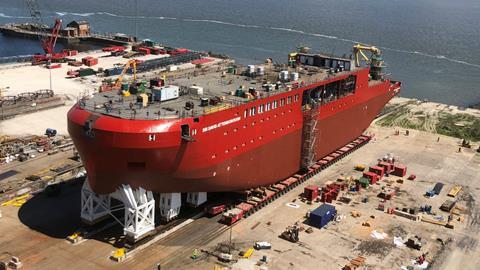The extension of the UK National Shipbuilding Strategy to commercial maritime shipbuilding, as well as a renewed focus on improving export competitiveness is a welcome step.
The announcement of a £4 billion investment in shipbuilding as part of the revamp of the UK’s National Shipbuilding Strategy (NSbS) may have dominated the headlines, but Prime Minister Boris Johnson’s policy represents a highly ambitious attempt to widen the base of civil shipbuilding in the country.
The strategy included a pipeline of 150 new naval and civil vessels that will be ordered by the UK government, as well as the governments of Scotland, Northern Ireland and Wales over the coming 30 years.
“RRS Sir David Attenborough during construction at Cammell Laird. The refreshed strategy envisages that a decision on a zero-emission replacement will be taken between 2040 and 2045.” “/ / 
Source: © British Antarctic Survey
RRS Sir David Attenborough during construction at Cammell Laird. The refreshed strategy envisages that a decision on a zero-emission replacement will be taken between 2040 and 2045.
The publication of the pipeline forms part of an attempt to support the raw materials and network of suppliers and sub-contractors necessary to maintain a domestic shipbuilding industry. The strategy explicitly sets the goal of broadening the number of suppliers to UK naval projects, which is expected to support the development of local supply chains and lead to improved efficiency (and ultimately export competitiveness).
Several reforms to naval procurement are also likely to support the development of wider supply chains within the country, including potential greater support for collaboration between competitors, as well as the separation of design, shipbuilding, commissioning, servicing, mission systems and propulsion stages during the procurement process.
It remains to be seen whether the pipeline will be sufficient to ensure adequate domestic supplies of raw materials: the UK’s domestic steel sector has seen capacity continue to decline amid high costs and competition from imported material.
UK-SHORE
The strategy also includes a significant £206 million investment in establishing and funding a UK Shipping Office for Reducing Emissions (UK-SHORE). UK-SHORE will fund research and development of zero emission vessels and infrastructure. The Motorshipreported on a UK research project into an innovative ammonia-fuelled 4-stroke engine technology earlier this month. The office will also have responsibility for accelerating investment in clean maritime technologies in UK ports.
UK MCA
A newly established maritime future technology team within the Maritime and Coastguard Agency (MCA) will have a similar focus on supporting emerging maritime technologies. The team, which has grown significantly in personnel and expertise in recent months, will act as a non-regulatory centre of technical expertise in the research and development of zero emission and autonomous vessel technology. The team is expected to play a facilitating role in the implementation of emerging technologies, guiding innovators through the regulatory process.
New scientific vessels
The strategy clarifies that a decision around replacing the research vessel RRS James Cook operated by UK Research and Innovation (UKRI) will be taken in 2023, while a decision on ordering a zero-carbon replacement for RRS Discovery will be taken between 2030 and 2035.
The current research vessel operated by the UK’s Centre for Environment, Fisheries and Aquaculture Science (Cefas), RV Cefas Endeavour, is approaching the end of its operational life. Work on defining the requirements of a new research vessel will begin in 2022.
Credit Guarantee scheme
The strategy also seeks to create a level playing field for local shipbuilders in the British market, introducing a new Home Shipbuilding Credit Guarantee Scheme to offer access to finance to underwrite domestic contracts. This addressed the anomalous situation where foreign shipyards were able to benefit from export credit guarantees when competing for contracts in the UK market, providing a level playing field. Local shipbuilders had identified this as a cause for concern.
Shipyard of the Future
While there is little prospect ofUK shipbuilding regainingcompetitiveness in lower margin, higher volume segments of the shipbuilding market, it is interesting to note that the strategy has established a goal of developing a Shipyard of the Future model, which will be drawn up by a Shipbuilding Enterprise for Growth committee. The model is intended to present a best practice guide for UK shipyards, and inform future investment decisions. The Motorship notes that the UK government’s new strategy directly recognises the challenge of developing and retaining skilled workers around the country, as well as the problem of truncated supply chains within the country, and the over concentration of high-end expertise within a small number of firms.
The publication of the refreshed UK National Shipbuilding Strategy in early March 2022 represents the most significant intervention in the UK’s maritime sector since the 1970s. However, it is worth contrasting the single-minded purpose with which some smaller nations tenaciously defended maritime interests in the 1960s and 1970s in the face of the emergence of lower cost, more efficient shipyards in East Asia and elsewhere, with the inconsistent approach UK politicians took then during a period of political instability. We will see whether the breadth of the strategic vision can be matched by the quality of the execution.





